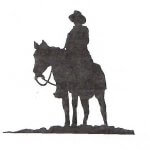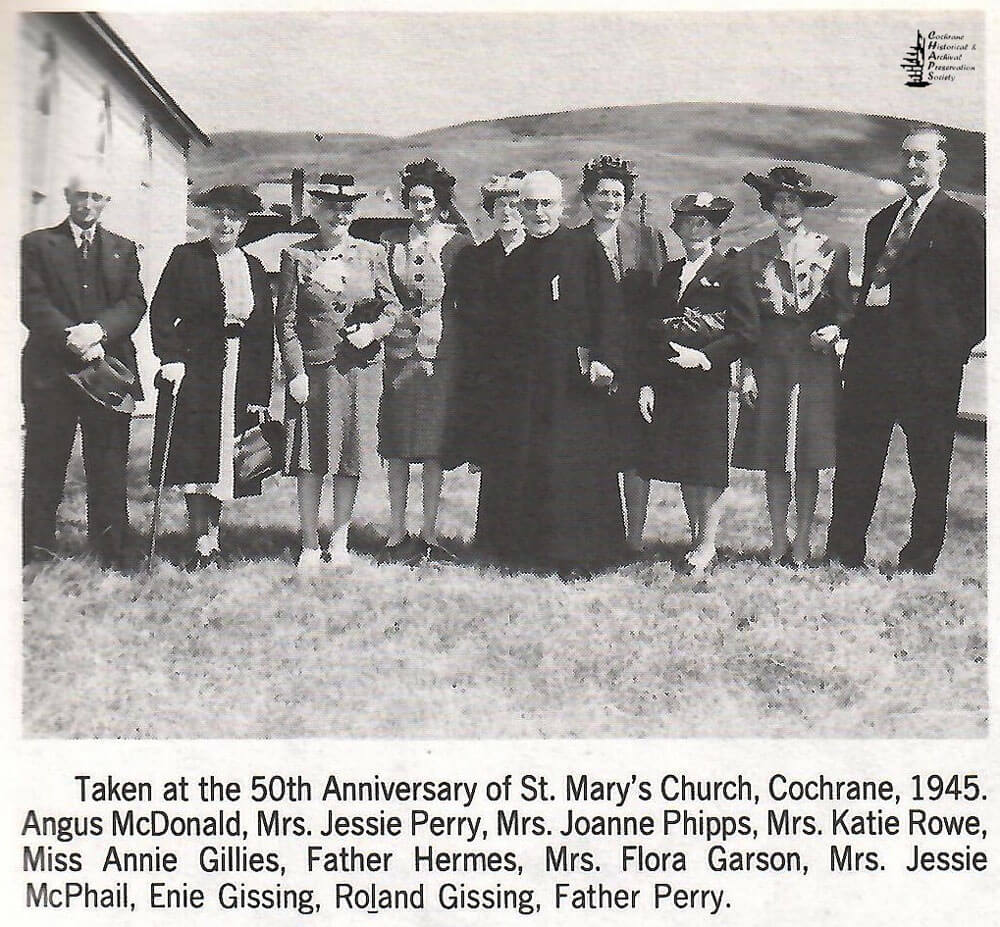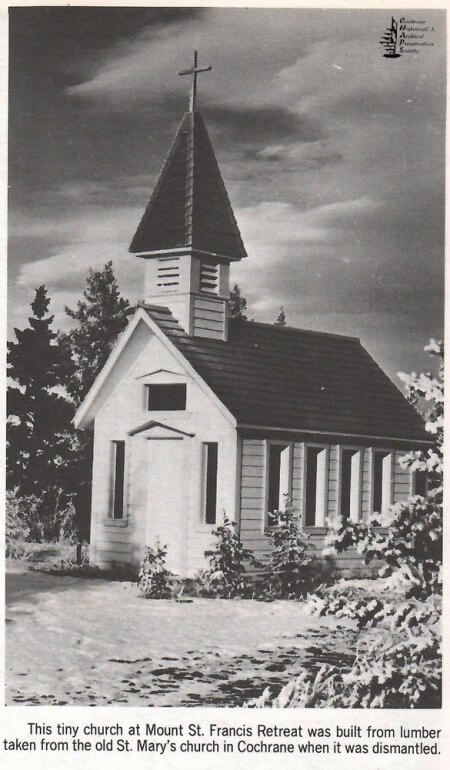— by Marjorie Spicer pg 172 Big Hill Country 1977
The latter part of the 19th Century witnessed the invasion of the white man to the wild and unknown country of the Blackfoot and Stoney Indians [sic].
In 1832 the Hudson’s Bay Company had built a trading post at Bow Fort but it had to be abandoned due to the hostility of the Indians [sic]. In 1840 missionaries started to come into the area. Explorers and surveyors were already here. Before the Palliser Expedition was sent west to seek a pass through the mountains, Rev. Father Pierre Jean DeSmets came to the valley of Bow by way of the Whiteman’s Pass. This was in 1845. He spent some time with the Stoney Indians [sic], and while among them performed what were perhaps the first baptisms in the Calgary diocese, when he brought six Indian [sic] children and one elderly man into the church.
Eleven years before the hamlet of Cochrane was founded, the first manifestation of Catholic life in Southern Alberta began when, on October 19, 1873, Reverend Fathers Fourmand and Scollen with their guide, Louis Dazé, left St. Albert (now a district in Edmonton) and travelled to the Elbow River, taking up residence in a log cabin built by Alexis Cardinal. This was a small cabin, 12 x 12. It was heated by an open hearth built of flat stones. The one window in the cabin was a thin parchment, and for a door, they used a tightly stretched rawhide. The parishioners were Blackfoot, Metis, and some trappers and traders, most of them having arrived in the area from the United States.
When winter was over Father Fourmand and Louis Dazé returned to St. Albert, while Father Scollen left to visit the camps of the buffalo hunters, who were mostly Metis, and other Indians [sic] who were scattered over the vast prairie. It took Father Scollen six months to make the trip ending at St. Albert on August 5, 1874.
In the summer of 1874, another great event was taking place; the North West Mounted Police were establishing themselves in the Northwest Territories. Having assisted at the annual retreat in St. Albert, Father Scollen, in company with Father Bonald and Louis Dazé, arrived back at the Elbow River Mission on November 2, 1874. Father Bonald was put in charge of the Mission, while the others organized a hunting party to get provisions for the winter. During this hunting trip, Louis Dazé was frozen to death in a snowstorm on November 22, 1874.
Louis Dazé’s body was taken to St. Albert for burial in the spring of 1875. Father Bonald and Alexis Cardinal took the body back, leaving on March 8, and arriving on March 22.
Two new priests were given their obediences for the Elbow River Mission, Fathers Touze and Doucet. They arrived at the Mission, on May 18, 1875.
In the fall of 1875 Father Scollen, who had been visiting at Fort Macleod and St. Albert, returned to join Father Doucet at the Mission. The North West Mounted Police were establishing a fort, and it was decided to close the Elbow River Mission and move to the same area as the Police Fort, which was twenty-five miles further east on the Elbow River. They felt that there would be a need for their services at the Fort, as there would be more white people arriving and more Indians would visit the post regularly. Thus, after two years, the missionary centre of Southern Alberta moved to Fort Calgary in October 1875.
The invasion of the whites, when it did come, was fast and furious. A number of ranches were being taken up in the Cochrane District. Some of these ranchers were Catholic immigrants from the Highlands of Scotland. In 1883 the arrival of the C.P.R. made transportation easier for the missionaries. They were able to visit mining and lumbering camps in the area, as well as hold services in private homes.
During the winter of 1894, a census was taken of Catholics in the Cochrane area, and it was found that there were eighty. Father Comire was asked to build a church. This was approved. James Johnstone, the father of Mrs. Frank Sibbald, donated one acre of land for the church. On September 25, 1895, Father Comire and Brother Patrick Bowes set to work building the church. Residents of the area, including many Protestants, were very generous, and the church was built free of any debts. The church was blessed Sunday, November 24, 1895. Father Lestanc performed the ceremony.
Father Comire was transferred from Cochrane and was replaced by Father Fouget. He remained until 1899. During his stay, he erected the Way of the Cross and started a collection for an organ loft. Father Culerier attended the Cochrane Parish for a few months in 1899.
On January 15, 1900, Father Seltman took charge of the Mission west of Calgary. In 1901 he built a small rectory at St. Mary’s in Cochrane. He obtained permission to take up residence there, remaining for only a few months. In Oc tober 1907, Father Hubert Hermes had charge of the missions west of Calgary. He remained with the Mission until 1921. During the summer, he would reside in Banff, and in the winter would alternate between Canmore and Cochrane. In 1908 an addition was added to the church. This was made necessary by the influx of Belgian and French workers at the Cochrane brickyards.
During his long tenure of ministry, Father Hermes was highly respected for his genuine concern for the human race. He had a charming manner and was a popular participant in sporting events.
After the departure of Father Hermes, diocesan priests took over the missions. First Father Greene and Father Stavinski resided at Cochrane. They were followed by Fathers McLaughlin, Dunbar, Cunningham, and Clancy. The last four visited Cochrane from St. Mary’s in Calgary. Father Jacob resided here for one winter, and Father Fitzpatrick for two years. Father Lyons made bi-monthly visits from St. Mary’s, Calgary.
In 1940 Bishop Carroll authorized the return of the parish to the Oblate Fathers and Father Lessard took up residence at Cochrane. Father Lessard, well remembered by all who knew him, was dedicated to helping the young people in the district, and through his efforts, a young people’s club was formed. Both Catholic and Protestant youngsters attended the weekly get-togethers and enjoyed many good times together.
With his help and encouragement, a newspaper came into being in Cochrane. It was called the Old Timer and was circulated to the four corners of the globe. Father Lessard took a great interest in all sports and was truly a sportsman. In 1946 he was transferred from Cochrane to a mission among the Blackfoot Indians. He passed away in 1966 and was laid to rest at St. Albert.
In 1939 a cairn was erected, nine miles south of Cochrane, at the site of the first Catholic mission in Southern Alberta. The land in the Mission Valley was owned at that time by the Mickle family. Charles Mickle donated the land for the cairn. It was dedicated to the memory of the first hardy missionaries that braved the wild country to help bring religion to the native people, as well as to the white settlers. When the cairn was dedicated, records of the mission were enclosed in a vault on the cairn. Someone broke into the vault, destroying all the valuable papers.
In 1945 St. Mary’s Church at Cochrane celebrated its fiftieth year. In 1959 a new church
was built. A replica of the first St. Mary’s Church was built by the Franciscan Order and can be seen on their spacious lawn at the Mount St. Francis Retreat, north of the town of Cochrane.
Part of the information for this history comes from material written by Father Lessard in 1945.





